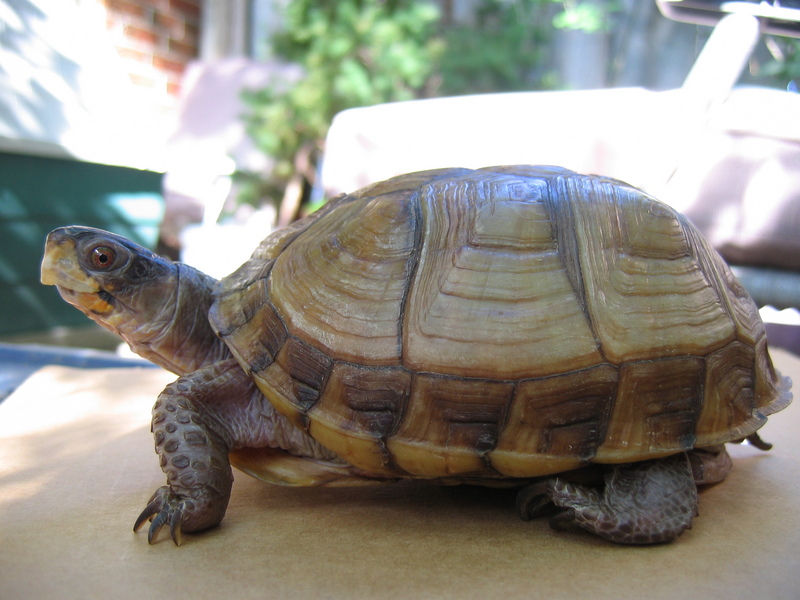Three-toed Box Turtle (Terrapene carolina triunguis) - Wiki Terrapene carolina triunguis
From Wikipedia, the free encyclopedia
[Photo] A female North American three-toed Box turtle, approximately 20 years old. She is an indoor pet. Camera Canon PowerShot A80 Photo taken on September 20, 2005.
The Three-toed Box Turtle (Terrapene carolina triunguis) is a subspecies within the group of hinge-shelled turtles commonly referred to as box turtles. This subspecies is native to the south-central part of the United States.
Description
Three toed box turtles are so named due to the number of toes on the hind feet, but some think that there are some 4-toed examples too. However, some speculate that the 4-toed individuals are actually Eastern box turtle + three toed box turtle hybrids. Three-toed box turtles have a domed shell which grows to an average 4.5 to 5 inches in length. The record for this subspecies is 7 inches. The highest part of its carapace or upper shell is more posteriorly positioned then in the other subspecies. The dorsal and limb coloration is commonly completely absent, although some dark blotches are common in adult turtles. These areas more often being a uniform olive green or tan color. Sometimes, faint yellow dots or lines are visible in the center of each large scute. The head and throat often display yellow, red, or orange spots. Frequently the bottom shell or plastron is a straw yellow color, and has far fewer dark markings than the plastrons of other subspecies.
Distribution & Habitat
From the west to the east of its range, the three-toed box turtle can be found from eastern Texas to the northern edge of the Florida Panhandle. Its northernmost habitat is in Missouri, while the southernmost is in Louisiana. Three-toes interbreed with other subspecies of eastern box turtles which overlap the borders of this area. An example of this occurs in the eastern Mississippi valley where this species is difficult to distinguish from the common box turtle. Being popular in the pet trade, three-toes are sometimes found well outside of their home range. It is not known whether such captives when released into the wild have any impact on the local species of such areas. These turtles are adaptive, and are possibly the only box turtle who can live happily in an indoor enclosure.
Diet
These turtles are omnivores, their diets varying with availability of food sources and the seasons. They are known to eat earthworms, insects, snails, slugs, strawberries, mushrooms, and green-leafed vegetation. They have been observed eating the eggs of quail. It should be noted however that all box turtles will prefer live foods to vegetation.
It has also been speculated that these turtles eat poisonous mushrooms, but are not themselves sickened by the mushroom's toxins. Afterwards, the turtles then become poisonous themselves. Carr believes this to be the reason why a group of boys in Mississippi became ill after eating roasted three-toed box turtles.
As pets, they have been reported to eat mealworms, crickets, waxworms, tomatoes and even moist dog food. They can be shy about being watched while eating, and may stop and stare back motionless if this happens.
Behavior
Three-toed box turtles are known to migrate seasonally in order to maintain their preferred humidity level. In Arkansas, three-toed box turtles were observed in grasslands in late spring, while in early spring, summer, and late fall they were found in forested areas. During dry times, they dig shallow burrows into leaf litter to conserve moisture. When water is available, these turtles soak for longer periods of time than any of the other subspecies.
Environment in Captivity
Three-toed box turtles require care similar to that of all eastern box turtles, faring best in large, outdoor enclosures. These enclosures should have plenty of room to allow the turtle to burrow, but should also be protected to prevent the turtle from burrowing under enclosure fencing. Indoors, three-toed box turtles should be kept in a 4x4 foot wooden enclosure for a single turtle. Do not keep any terrestrial turtle in an aquarium, because turtles do not understand the concept of glass and will become extremely stressed if no visual barrier is given. The enclosure should have a high temperature side with a heat bulb at around 85°F and a lower temperature side at 70°F. The enclosure should also contain a hiding spot for the turtle as well as an area where it can soak. Peat moss bedding at around 80% humidity (moist but not wet) is preferred for these box turtles. Desert materials such as gravel or sand would be too dry and difficult for the turtle to dig into, and will cause small scratches susceptible to infections. Many owners simply spray the surface area of the enclosure down at the beginning of the day in order to moisten the material and to increase the humidity of the enclosure.
http://en.wikipedia.org/wiki/Terrapene_carolina_triunguis
| The text in this page is based on the copyrighted Wikipedia article shown in above URL. It is used under the GNU Free Documentation License. You may redistribute it, verbatim or modified, providing that you comply with the terms of the GFDL. |
